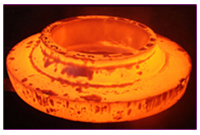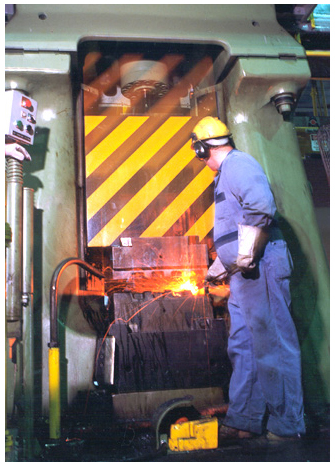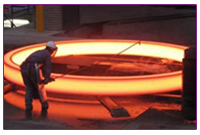
There are basically three methods (or processes) to make a forged part.
Impression Die Forging
Impression die forging pounds or presses metal between two dies (called tooling) that contain a precut profile of the desired part. Parts from a few ounces to 60,000 lbs. can be made using this process. Some of the smaller parts are actually forged cold.
PROCESS OPERATIONS
Graphical depiction of process steps.
Process Capabilities
 Commonly referred to as closed-die forging, impression-die forging of steel, aluminum, titanium and other alloys can produce an almost limitless variety of 3-D shapes that range in weight from mere ounces up to more than 25 tons. Impression-die forgings are routinely produced on hydraulic presses, mechanical presses and hammers, with capacities up to 50,000 tons, 20,000 tons and 50,000 lbs. respectively.
Commonly referred to as closed-die forging, impression-die forging of steel, aluminum, titanium and other alloys can produce an almost limitless variety of 3-D shapes that range in weight from mere ounces up to more than 25 tons. Impression-die forgings are routinely produced on hydraulic presses, mechanical presses and hammers, with capacities up to 50,000 tons, 20,000 tons and 50,000 lbs. respectively.
As the name implies, two or more dies containing impressions of the part shape are brought together as forging stock undergoes plastic deformation. Because metal flow is restricted by the die contours, this process can yield more complex shapes and closer tolerances than open-die forging processes. Additional flexibility in forming both symmetrical and non- symmetrical shapes comes from various preforming operations (sometimes bending) prior to forging in finisher dies.
Part geometry's range from some of the easiest to forge simple spherical shapes, block-like rectangular solids, and disc-like configurations to the most intricate components with thin and long sections that incorporate thin webs and relatively high vertical projections like ribs and bosses. Although many parts are generally symmetrical, others incorporate all sorts of design elements (flanges, protrusions, holes, cavities, pockets, etc.) that combine to make the forging very non-symmetrical. In addition, parts can be bent or curved in one or several planes, whether they are basically longitudinal, equidimensional or flat.
Most engineering metals and alloys can be forged via conventional impression-die processes, among them: carbon and alloy steels, tool steels, and stainless, aluminum and copper alloys, and certain titanium alloys. Strain-rate and temperature-sensitive materials (magnesium, highly alloyed nickel-based superalloys, refractory alloys and some titanium alloys) may require more sophisticated forging processes and/or special equipment for forging in impression dies.
Cold Forging
Most forging is done as hot work, at temperatures up to 2300 degrees F, however, a variation of impression die forging is cold forging. Cold forging encompasses many processes -- bending, cold drawing, cold heading, coining, extrusions and more, to yield a diverse range of part shapes. The temperature of metals being cold forged may range from room temperature to several hundred degrees.
Process Operations
Graphical depiction of process steps.
Process Capabilities
Cold forging encompasses many processes bending, cold drawing, cold heading, coining, extrusion, punching, thread rolling and more to yield a diverse range of part shapes. These include various shaft-like components, cup-shaped geometry's, hollow parts with stems and shafts, all kinds of upset (headed) and bent configurations, as well as combinations.
Most recently, parts with radial flow like round configurations with center flanges, rectangular parts, and non-axisymmetric parts with 3- and 6-fold symmetry have been produced by warm extrusion. With cold forging of steel rod, wire, or bar, shaft-like parts with 3-plane bends and headed design features are not uncommon.
Typical parts are most cost-effective in the range of 10 lbs. or less; symmetrical parts up to 7 lbs. readily lend themselves to automated processing. Material options range form lower-alloy and carbon steels to 300 and 400 series stainless, selected aluminum alloys, brass and bronze.
There are times when warm forging practices are selected over cold forging especially for higher carbon grades of steel or where in-process anneals can be eliminated.
Often chosen for integral design features such as built-in flanges and bosses, cold forgings are frequently used in automotive steering and suspension parts, antilock-braking systems, hardware, defense components, and other applications where high strength, close tolerances and volume production make them an economical choice.
In the process, a chemically lubricated bar slug is forced into a closed die under extreme pressure. The unheated metal thus flows into the desired shape. As shown, forward extrusion involves steel flow in the direction of the ram force. It is used when the diameter of the bar is to be decreased and the length increased. Backward extrusion, where the metal flows opposite to the ram force, generates hollow parts. In upsetting, the metal flows at right angles to the ram force, increasing diameter and reducing length.
Open Die Forging
Open die forging is performed between flat dies with no precut profiles is the dies. Movement of the work piece is the key to this method. Larger parts over 200,000 lbs. and 80 feet in length can be hammered or pressed into shape this way.
PROCESS OPERATIONS
Graphical depiction of process steps.
Process Capabilities
 Open-die forging can produce forgings from a few pounds up to more than 150 tons. Called open-die because the metal is not confined laterally by impression dies during forging, this process progressively works the starting stock into the desired shape, most commonly between flat-faced dies. In practice, open-die forging comprises many process variations, permitting an extremely broad range of shapes and sizes to be produced. In fact, when design criteria dictate optimum structural integrity for a huge metal component, the sheer size capability of open-die forging makes it the clear process choice over non-forging alternatives. At the high end of the size range, open-die forgings are limited only by the size of the starting stock, namely, the largest ingot that can be cast.
Open-die forging can produce forgings from a few pounds up to more than 150 tons. Called open-die because the metal is not confined laterally by impression dies during forging, this process progressively works the starting stock into the desired shape, most commonly between flat-faced dies. In practice, open-die forging comprises many process variations, permitting an extremely broad range of shapes and sizes to be produced. In fact, when design criteria dictate optimum structural integrity for a huge metal component, the sheer size capability of open-die forging makes it the clear process choice over non-forging alternatives. At the high end of the size range, open-die forgings are limited only by the size of the starting stock, namely, the largest ingot that can be cast.
Practically all forgeable ferrous and non-ferrous alloys can be open-die forged, including some exotic materials like age-hardening superalloys and corrosion-resistant refractory alloys.
Open-die shape capability is indeed wide in latitude. In addition to round, square, rectangular, hexagonal bars and other basic shapes, open-die processes can produce:
- Step shafts solid shafts (spindles or rotors) whose diameter increases or decreases (steps down) at multiple locations along the longitudinal axis.
- Hollows cylindrical in shape, usually with length much greater than the diameter of the part. Length, wall thickness, ID and OD can be varied as needed.
- Ring-like parts can resemble washers or approach hollow cylinders in shape, depending on the height/wall thickness ratio.
- Contour-formed metal shells like pressure vessels, which may incorporate extruded nozzles and other design features.
Not unlike successive forging operations in a sequence of dies, multiple open-die forging operations can be combined to produce the required shape. At the same time, these forging methods can be tailored to attain the proper amount of total deformation and optimum grain-flow structure, thereby maximizing property enhancement and ultimate performance for a particular application. Forging an integral gear blank and hub, for example, may entail multiple drawing or solid forging operations, then upsetting. Similarly, blanks for rings may be prepared by upsetting an ingot, then piercing the center, prior to forging the ring.
Seamless Rolled Ring Forging
Seamless rolled ring forging is typically performed by punching a hole in a thick, round piece of metal (creating a donut shape), and then rolling and squeezing (or in some cases, pounding) the donut into a thin ring. Ring diameters can be anywhere from a few inches to 30 feet.
PROCESS OPERATIONS
Graphical depiction of process steps.
Process Capabilities
 Rings forged by the seamless ring rolling process can weigh < 1 lb up to 350,000 lbs., while O.D.’s range from just a few inches up to 30-ft. in diameter. Performance-wise, there is no equal for forged, circular-cross-section rings used in energy generation, mining, aerospace, off-highway equipment and other critical applications.
Rings forged by the seamless ring rolling process can weigh < 1 lb up to 350,000 lbs., while O.D.’s range from just a few inches up to 30-ft. in diameter. Performance-wise, there is no equal for forged, circular-cross-section rings used in energy generation, mining, aerospace, off-highway equipment and other critical applications.
Seamless ring configurations can be flat (like a washer), or feature higher vertical walls (approximating a hollow cylindrical section). Heights of rolled rings range from less than an inch up to more than 9 ft. Depending on the equipment utilized, wall-thickness/height ratios of rings typically range from 1:16 up to 16:1, although greater proportions have been achieved with special processing. In fact, seamless tubes up to 48-in. diameter and over 20-ft long are extruded on 20 to 30,000-ton forging presses.
Even though basic shapes with rectangular cross-sections are the norm, rings featuring complex, functional cross- sections can be forged to meet virtually any design requirements. Aptly named, these contoured rolled rings can be produced in thousands of different shapes with contours on the inside and/or outside diameters. A key advantage to contoured rings is a significant reduction in machining operations. Not surprisingly, custom-contoured rings can result in cost-saving part consolidations. Compared to flat-faced seamless rolled rings, maximum dimensions (face heights and O.D.’s) of contoured rolled rings are somewhat lower, but are still very impressive in size.
High tangential strength and ductility make forged rings well-suited for torque- and pressure-resistant components, such as gears, engine bearings for aircraft, wheel bearings, couplings, rotor spacers, sealed discs and cases, flanges, pressure vessels and valve bodies. Materials include not only carbon and alloy steels, but also non-ferrous alloys of aluminum, copper and titanium, as well as nickel-base alloys.




